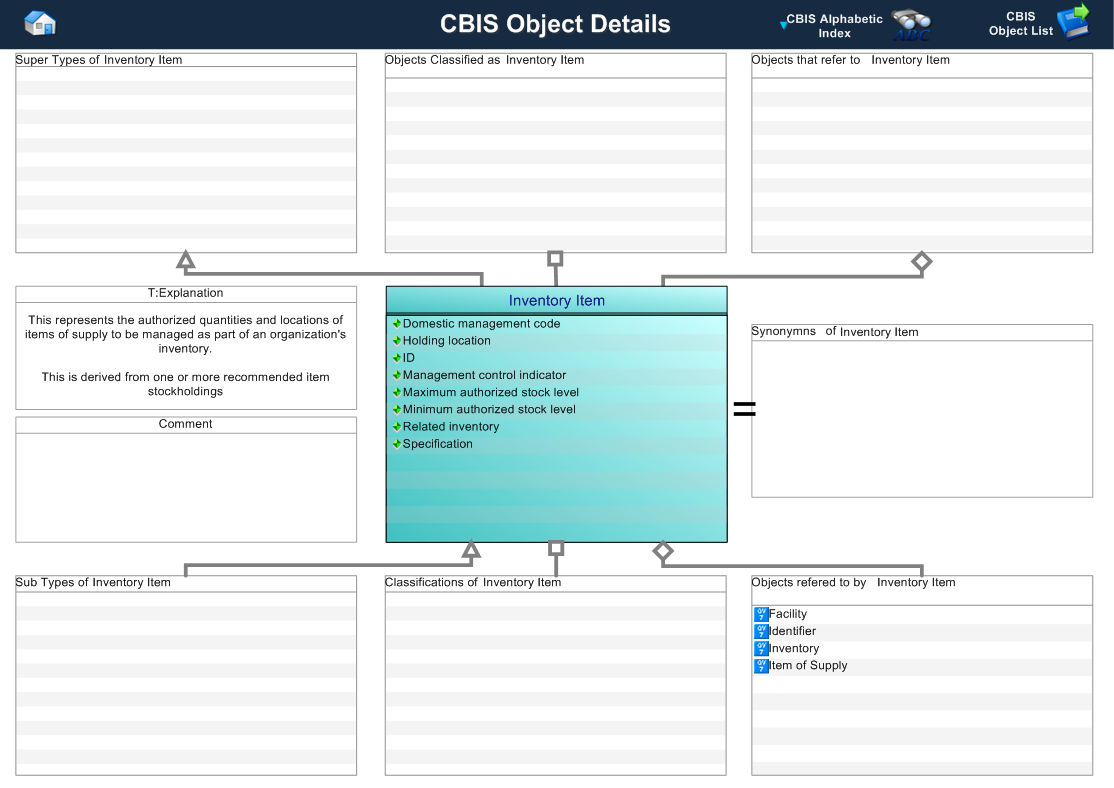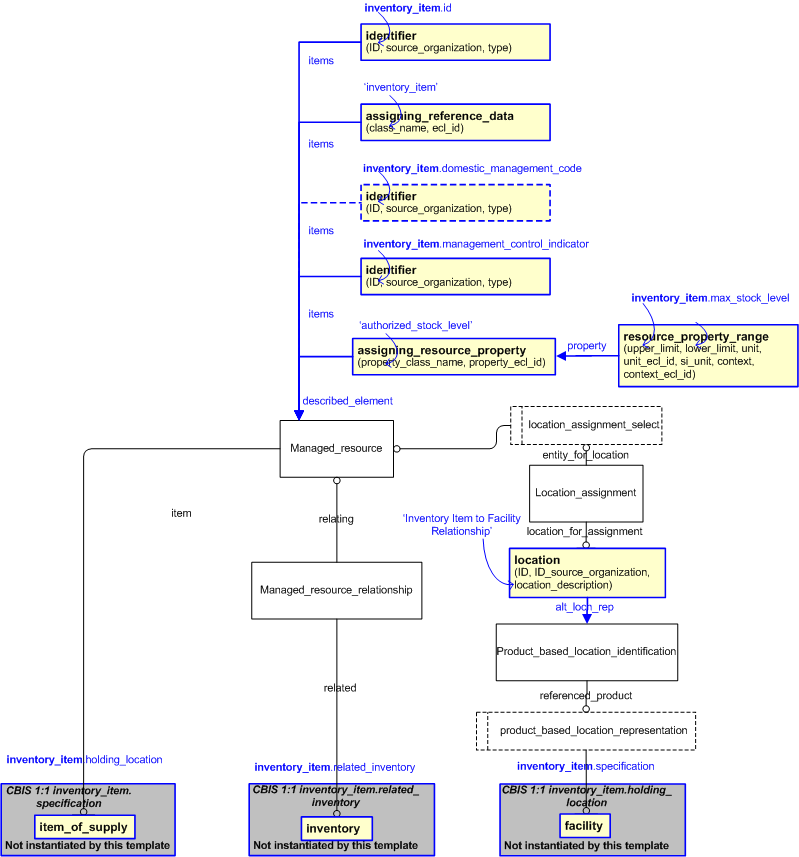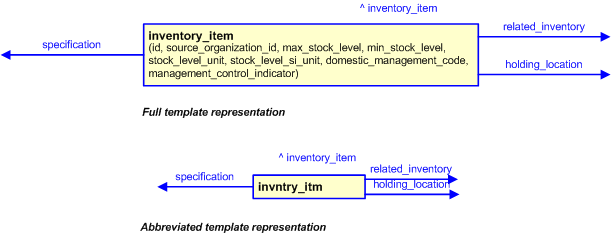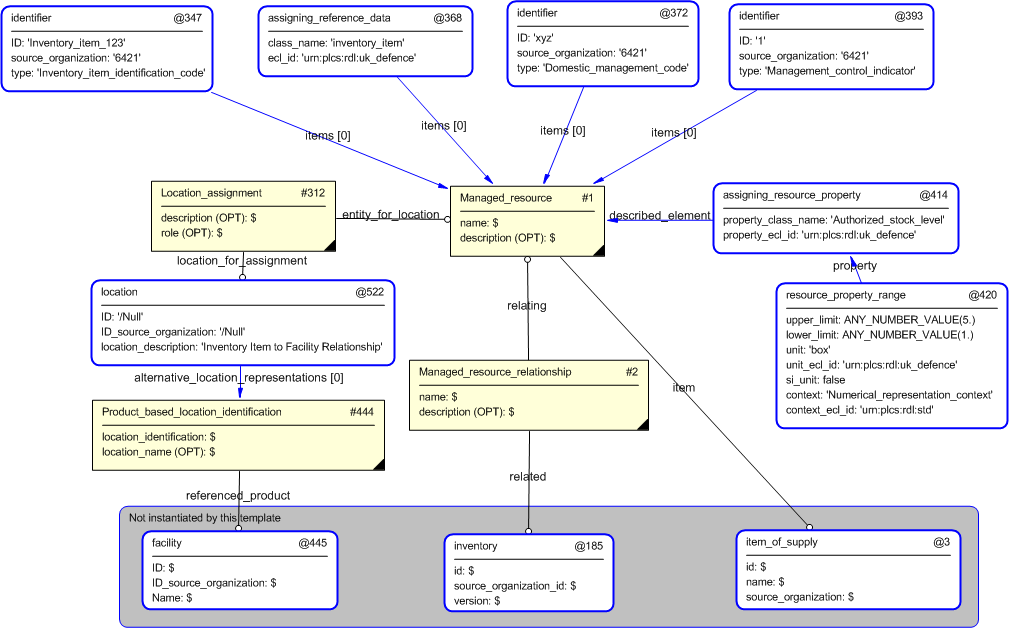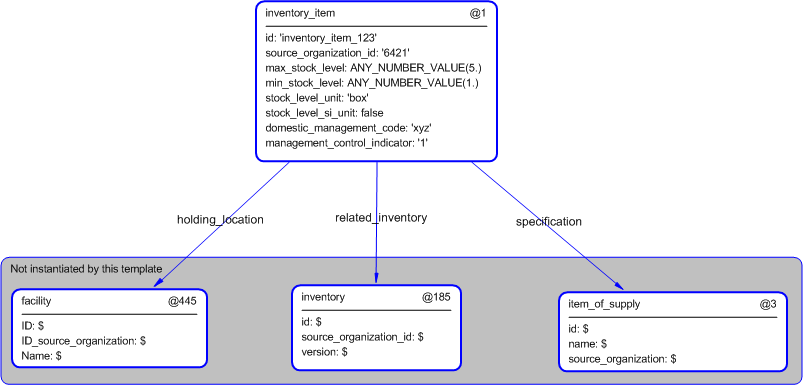Template:— inventory_item (invntry_itm)
Context:— UK_Defence |
Date: 2010/03/18 11:15:54
Revision: 1.13
|
This section specifies the template inventory_item.
NOTE
The template has been defined in the context of
UK_Defence.
Refer to the business context for details of related templates.
NOTE
An explanation of a template and the associated instantiation path is
provided in the
Template overview
section.
This template describes how to represent the authorized quantities and locations of items of supply to be managed as part
of an organization's inventory.
A Inventory Item is the representation of authorized quantities and locations of items of supply to be managed as part of
an organization's inventory.
Figure 1 — Graphical Representation for Business Object inventory_item
inventory_item
The definition of an inventory_item object is:
This represents the authorized quantities and locations of items of supply to be managed as part of an organization's
inventory.
This is derived from one or more recommended item stockholdings.
|
Attribute name
|
Attribute description
|
Attribute type
|
Optionality
|
| Domestic management code |
This is a code allocated by Equipment Managers to groups of items of supply for inventory management purposes. Related terms
are Inventory Management Code (IMC) and Supply Management Branch Indicator (SMBI).
|
intrinsic |
Optional |
| Holding location |
This is the location where the inventory item is to be held. |
Relationship to Facility |
Mandatory |
| ID |
This is the identifier of the inventory. |
Identifier |
Mandatory |
| Identifier.id |
This is the value of the id attribute of the Identifier applied to the inventory item. |
intrinsic |
Mandatory |
| Identifier.type |
This attribute is the type associated with the id of the Identifier given to the inventory item. |
inventory_item_id_code |
Mandatory |
| Identifier.source_organization |
This attribute is the value representing the source organization that provides the id of the Identifier given to the inventory
item. This value is assumed to be a type of Organization_identification_code.
|
Organization_identification_code |
Mandatory |
| Management control indicator |
This is an indicator of whether the inventory item requires specific management action prior to issue.
EXAMPLE:
If sources of supply are at risk, this may cause issues of the item to be restricted.
|
intrinsic |
Mandatory |
| Maximum authorized stock level |
This is the maximum authorized quantity of inventory items to be held at a location or facility. |
intrinsic |
Mandatory |
| Minimum authorized stock level |
This is the minimum authorized quantity of inventory items to be held at a location or facility. |
intrinsic |
Mandatory |
| Related inventory |
This is a reference to the inventory within which this item is managed |
Relationship to Inventory |
Mandatory |
| Specification |
This is a reference to the Item of supply that is that defines the inventory item. |
Relationship to Item of Supply |
Mandatory |
Table 1 — inventory_item attribute details
The EXPRESS-G diagram in
Figure
2
shows the templates and EXPRESS entities that are required
to represent the template
"inventory_item".
The text highlighted in blue shows the template parameters.
Figure 2 — An EXPRESS-G representation of the Information model for inventory_item
The graphic for the template to be used in other EXPRESS-G diagrams
is shown in Figure
3
below.
Figure 3 — The graphical representation of the inventory_item template
The following input parameters are defined for this template:
This is a reference to the Item of supply that is that defines the inventory.
This is a reference to the inventory within which this item is managed.
This is the location (facility) where the inventory item is to be held.
The identifier assigned to the inventory item
The organization providing the identifier to the inventory item.
The quantity of the demanded resource.
The quantity of the demanded resource.
The units of measure for the quantity of the demanded resource.
The following classes and their sub-classes can be used:
Value should be set to true if the unit is a SI base unit defined by ISO, i.e.
kilogram (kg) for Mass,
second (s) for Time,
metre (m) for Displacement,
ampere (A) for Electrical current,
kelvin (K) for Temperature,
mole (mol) for Amount of substance, and
candela (cd) for Luminous intensity. If this is not the case it should be set to false.
Note that the representation of true and false depends on exchange format. In Part 11 (a STEP file) true is
represented by the string ".T.", and false by ".F.", while in Part 28 (XML) they are represented by text strings
"true"
and "false".
This is a code allocated by Equipment Managers to groups of items of supply for inventory management purposes. Related terms
are Inventory Management Code (IMC) and Supply Management Branch Indicator (SMBI).
This is an indicator of whether the inventory item requires specific management action prior to issue.
EXAMPLE:
If sources of supply are at risk, this may cause issues of the item to be restricted.
The following reference parameters are defined for this template:
Allow the
Managed_resource
entity instantiated in this path to be referenced when this template is used.
%^target = $inventory_item.inventory_item%
The instantiation path shown below specifies the entities that are to be
instantiated by the template.
A description of templates and the syntax for the instantiation path is
provided in the
Templates Help/Information section.
-- create the inventory_item %^inventory_item =
Managed_resource%
^inventory_item.name = '/IGNORE'
^inventory_item.description = '/IGNORE'
-- Note the optional Managed_resource.quantity attribute is left unused
^inventory_item.item ->
@specification-- Inventory item id /
identifier(
ID=@id,
source_organization=@source_organization_id,
type='Inventory_item_identification_code',
items=^inventory_item)/
-- not explicitly required but may need to classify different Managed resource instances. /
assigning_reference_data(
class_name='Inventory_item',
ecl_id='urn:plcs:rdl:UK_Defence',
items=^inventory_item)/
-- tjt to consider deleting this -- assign the authorized_stock_levels /
assigning_resource_property(
property_class_name='Authorized_stock_level',
property_ecl_id='urn:plcs:rdl:UK_Defence',
described_element=^inventory_item)/
-- Assign local reference parameter %^min_max_stock_level = $assigning_resource_property.property%
-- Create the max and min stock level property Value and Unit /
resource_property_range(
upper_limit=@max_stock_level,
lower_limit=@min_stock_level,
unit=@stock_level_unit,
unit_ecl_id='urn:plcs:rdl:uk_defence',
si_unit=@stock_level_si_unit,
context='Numerical_representation_context',
context_ecl_id='urn:plcs:rdl:std',
property=^min_max_stock_level)/
-- domestic_management_code /
identifier(
ID=@domestic_management_code,
source_organization=@source_organization_id,
type='Domestic_management_code',
items=^inventory_item)/
-- Management_control_indicator /
identifier(
ID=@management_control_indicator,
source_organization=@source_organization_id,
type='Management_control_indicator',
items=^inventory_item)/
-- related_inventory Managed_resource_relationshipManaged_resource_relationship.name = '/IGNORE'
Managed_resource_relationship.relating ->
^inventory_item
Managed_resource_relationship.related ->
@related_inventory-- holding_location Product_based_location_identificationProduct_based_location_identification.location_identification = '/IGNORE'
Product_based_location_identification.location_name = '/IGNORE'
Product_based_location_identification.referenced_product ->
@holding_location/
location(
ID='/Null',
ID_source_organization='/Null',
location_description='Inventory Item to Facility Relationship')/
%^locale = $location.location%
Location_assignmentLocation_assignment.role = '/IGNORE'
Location_assignment.location_for_assignment ->
^locale
Location_assignment.entity_for_location ->
^inventory_item
^locale.alternative_location_representations ->
Product_based_location_identification
The following entities are instantiated with attributes as specified:
The instance diagram in Figure
4
shows an example of the EXPRESS entities and templates that are instantiated by the template:
/inventory_item(items='#1', class_name='Safety_critical', ecl_id='urn:plcs:rdl:std')/
(an illustration of the consolidated inventory_item template is shown in
Figure
5 below.)
Figure 4 — Entities instantiated by inventory_item template
The instance diagram in
Figure
5
shows the graphic symbol for the template that is to be
used in other instance diagrams. The example template is:
/inventory_item(items='#1', class_name='Safety_critical', ecl_id='urn:plcs:rdl:std')/
Figure 5 — Instantiation of inventory_item template
Characterizations
No common characterizations of the template
inventory_item
have been identified. However, the ISO 10303-239 EXPRESS model
may enable other assignments to the entities instantiated by the template.
